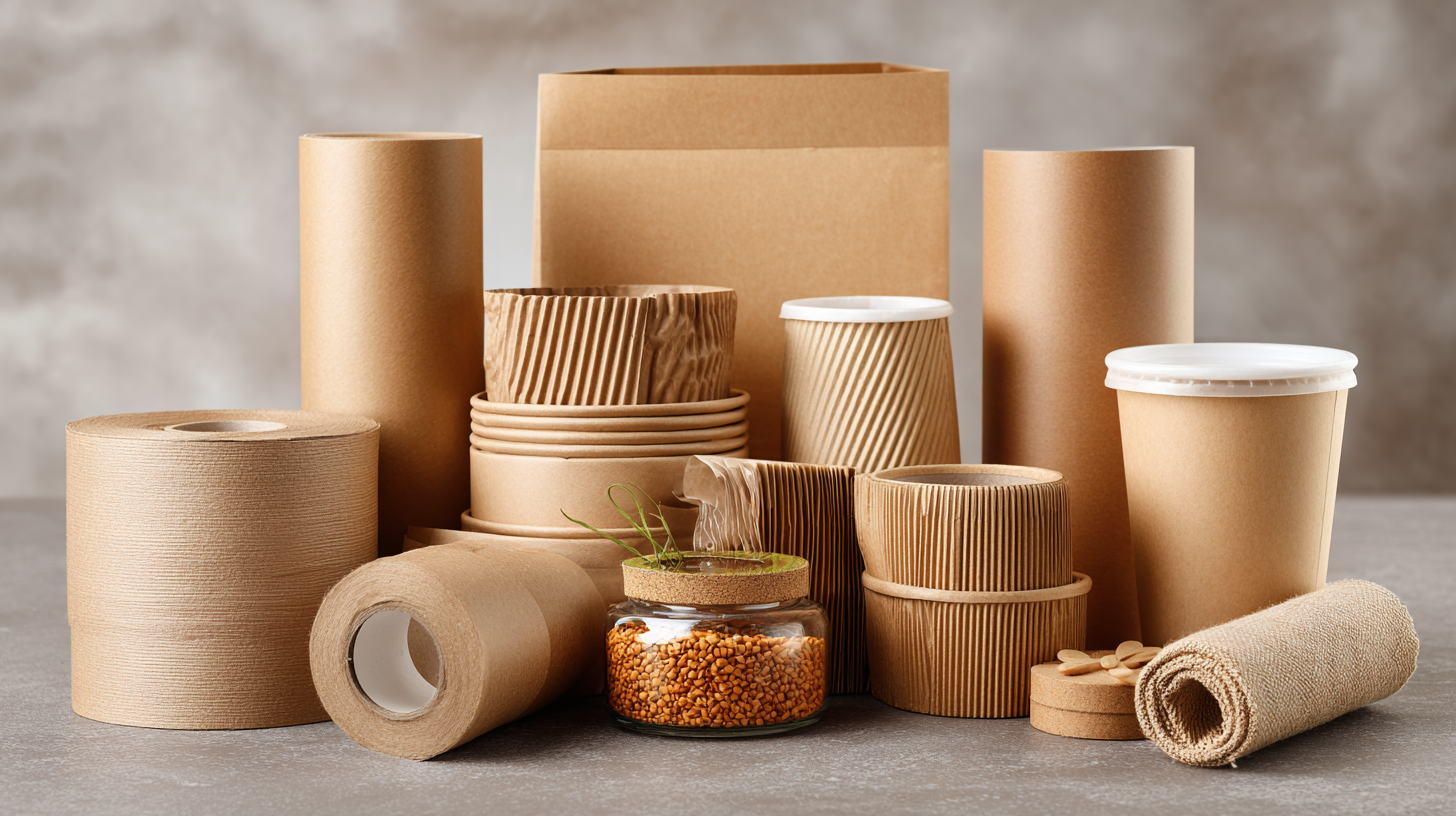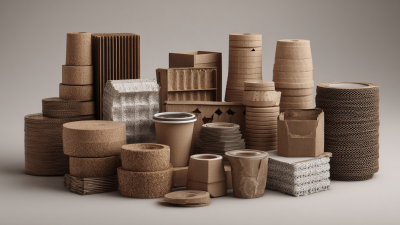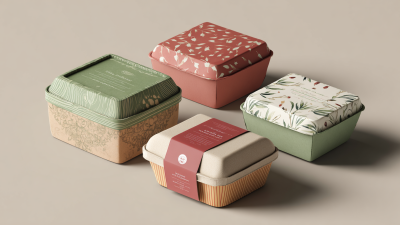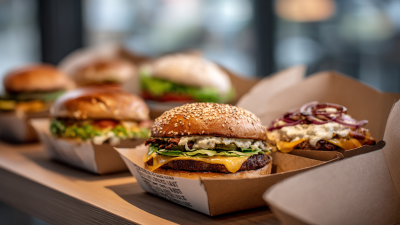What Are Food Packaging Materials? Essential Types and Their Uses Explained
In the ever-evolving landscape of food packaging materials, understanding the essential types and their uses is crucial for ensuring food safety and sustainability. As we approach 2025, the demand for innovative and eco-friendly packaging solutions continues to rise. Industry expert Dr. Emily Carter, a leading researcher in food technology, emphasizes the importance of this transition, stating, "The future of food packaging materials lies in our ability to blend functionality with environmental responsibility."

Today, a variety of materials are utilized in food packaging, each serving specific purposes to preserve freshness, enhance shelf life, and maintain product integrity. From traditional plastics to biodegradable options, each material presents unique benefits and challenges. As manufacturers and consumers alike become more conscious of their environmental impact, the shift towards sustainable food packaging materials is not just a trend, but a necessity to meet both regulatory standards and consumer expectations.
As we explore the top types of food packaging materials in this article, we will delve into their various applications, benefits, and the innovative technologies shaping the future of the industry. Understanding these materials is not only essential for producers but also for consumers who seek to make informed choices about the products they purchase and consume.
Types of Food Packaging Materials: Key Options Explained
Food packaging materials
play a crucial role in ensuring the safety, quality, and shelf life of products. Among the essential types are plastics, which are widely used due to their versatility and durability. They come in various forms, including flexible and rigid packaging, making them suitable for everything from snacks to beverages. Plastics also offer excellent barrier properties, protecting food from moisture, oxygen, and contaminants.
 Paper and paperboard are another key category, favored for their sustainability and recyclability. They are commonly used for packaging items such as cereal boxes, takeout containers, and paper bags. Metal packaging, including aluminum and steel, is noted for its strength and ability to preserve food, making it ideal for canned goods. Additionally, glass offers an inert and non-reactive option that keeps food fresh and free from contamination, while wooden packaging is often used for specialty products, such as wine cases. Each of these materials has distinct benefits and applications, contributing to the diverse landscape of food packaging solutions.
Paper and paperboard are another key category, favored for their sustainability and recyclability. They are commonly used for packaging items such as cereal boxes, takeout containers, and paper bags. Metal packaging, including aluminum and steel, is noted for its strength and ability to preserve food, making it ideal for canned goods. Additionally, glass offers an inert and non-reactive option that keeps food fresh and free from contamination, while wooden packaging is often used for specialty products, such as wine cases. Each of these materials has distinct benefits and applications, contributing to the diverse landscape of food packaging solutions.
Benefits of Using Sustainable Packaging in Food Industry
Sustainable packaging in the food industry plays a crucial role in reducing environmental impact while ensuring food safety and quality. By opting for materials that are biodegradable, recyclable, and made from renewable resources, companies can significantly lower their carbon footprint. This shift not only benefits the planet but also enhances brand reputation, as consumers increasingly seek products that align with their values of sustainability and health.
Tips for adopting sustainable packaging include conducting a materials audit to assess current packaging options, exploring alternative materials such as plant-based plastics or recycled paper, and collaborating with suppliers who prioritize eco-friendly practices. Engaging with customers through transparent communication about packaging choices can also foster a stronger bond and enhance loyalty.
Additionally, making small changes, such as reducing packaging size or eliminating unnecessary elements, can lead to significant sustainability gains. Companies should continuously evaluate the performance of their chosen materials to ensure they meet both functional and environmental goals, thus committing to a more sustainable future in the food industry.
Innovative Materials: The Future of Food Packaging
The food packaging industry is undergoing a significant transformation with the emergence of innovative materials poised to shape the future. According to a report by MarketsandMarkets, the global food packaging market is expected to reach USD 500 billion by 2025, growing at a CAGR of 5.1%. This growth is largely driven by the increasing demand for sustainable packaging solutions that prioritize environmental impact alongside functionality.
Materials such as biodegradable plastics, edible films, and smart packaging technologies are leading the charge in this evolution.
Biodegradable materials are becoming increasingly popular as consumers and manufacturers recognize the need to reduce plastic waste. Research from the World Economic Forum highlights that around 30% of plastic packaging is not recycled, underscoring the urgency for alternatives. Innovations like polylactic acid (PLA) and other bio-based plastics offer a viable solution, as they break down more efficiently in industrial composting environments, thus minimizing their ecological footprint.
Furthermore, smart packaging—equipped with sensors to monitor food freshness and safety—enhances food quality while reducing waste, responding to the demands of a conscious consumer base seeking both convenience and sustainability.

Essential Tips for Choosing the Right Food Packaging
Food packaging plays a crucial role in ensuring food safety and maintaining quality, especially during festive seasons like the Lantern Festival, where traditional treats such as tangyuan are widely consumed. As consumers become increasingly aware of food safety concerns, it is essential to select appropriate packaging that not only protects the food but also adheres to hygiene standards. According to recent projections, the food packaging market is expected to grow significantly, with plastic packaging anticipated to see a compound annual growth rate of 3.54% from 2024 to 2032, reaching a market value of $14.3 billion by 2032.
When choosing the right food packaging, it’s vital to consider several factors. First, opt for materials that are safe and appropriate for the type of food being packaged. Recyclable materials can significantly reduce environmental impact, aligning with the growing trend of sustainable packaging solutions. Second, ensure that the packaging is designed to extend shelf life and maintain the integrity of food products. This is especially important as urbanization increases reliance on packaged foods, which demand high standards for safety and quality.
Lastly, pay attention to labeling and nutritional information on packaging. With regulations evolving, clear and accurate labeling can help consumers make informed choices, especially concerning health and nutrition. Understanding these aspects of food packaging can empower consumers to make safer and more sustainable choices in their food consumption habits.
What Are Food Packaging Materials? Essential Types and Their Uses Explained
| Packaging Material | Type | Uses | Advantages |
|---|---|---|---|
| Plastic | Flexible | Bottles, Bags | Lightweight, Durable |
| Glass | Rigid | Jars, Bottles | Recyclable, Non-reactive |
| Cardboard | Rigid | Boxes, Packaging | Eco-friendly, Cost-effective |
| Aluminum | Rigid/Flexible | Cans, Foil | Lightweight, Barrier Protection |
| Biodegradable Plastics | Flexible | Bags, Containers | Sustainable, Reduced Waste |
Common Mistakes to Avoid When Selecting Packaging Materials
When selecting food packaging materials, it's crucial to avoid common pitfalls that can lead to product spoilage or customer dissatisfaction. One frequent mistake is overlooking the compatibility of materials with the food type. For example, acidic foods may react negatively with certain plastics, resulting in leaching and contamination. Always ensure that the packaging is specifically designed for the food it contains to maintain safety and quality.
Another common error is underestimating the importance of barrier properties. Different foods require varying levels of protection from moisture, oxygen, and light to prevent spoilage. Failing to choose packaging materials with adequate barrier properties can lead to a shortened shelf life and compromised flavor. Additionally, neglecting to consider environmental factors, such as recyclability or compostability, may alienate eco-conscious consumers. By avoiding these mistakes, businesses can select the most effective packaging solutions that preserve their products and align with market demands.
Common Types of Food Packaging Materials and Their Uses
Related Posts
-

Revolutionizing Sustainable Food Packaging Solutions for a Greener Future
-

Innovative Trends in Food Packaging Design You Need to Know for Sustainable Choices
-

Innovative Packaging Materials Transforming Sustainability in the Modern Age
-

Transforming Sustainability in Food Packaging: How Eco-Friendly Materials are Reshaping Consumer Choices
-

Exploring Sustainable Trends in Food Packaging Design for a Greener Future
-

Creative Burger Packaging Ideas for Sustainable Fast Food Solutions
